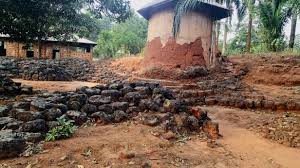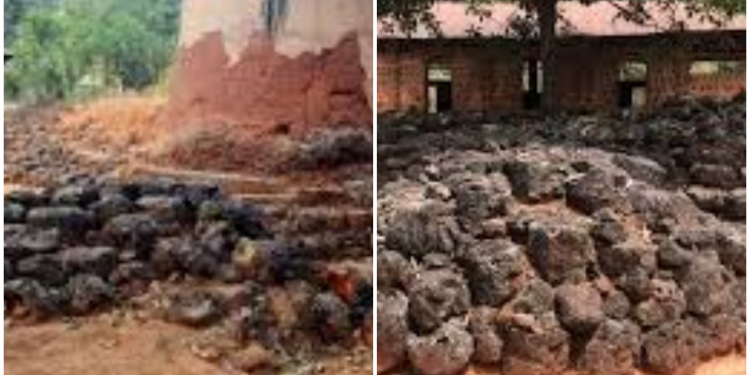In an ancient and obscure Enugu community, many modern historians of international repute are eagerly trying to rewrite the Igbo, nay world history with the discovery of startling archaeological artefacts.
Tucked away with about 15km from Nsukka, the city centre, Lejja community has continued to play host to tens of both national and international researchers from world renowned universities who are neck deep into the origin of hundreds of historic artefacts discovered some years back in the community.

Archaeological discovery of iron smelting 2, 000 years ago has gradually turned the town into a mini tourism centre of some sort.
Experts speak on the discovery
In any case, when WITHIN NIGERIA visited Amagu-Enu village, site of the iron smelting, many other researchers from the country were already there making researches. The site was indeed a beehive of activities.
By and large, when our reporter made a visit to one of the early researchers of the site, Dr. Chris Opata, he explained that he started research on the site in 1994 as an undergraduate of the University of Nigeria, Nsukka (UNN).

Dr. Opata, who is currently a senior lecturer in the Department of History, UNN and Chairman Academic Staff Union of universities (ASUU), UNN chapter said: “I started working on the site as an undergraduate in 1994. The site is the square where the 33 villages meet. It was where all the council of elders meet for their legislation.”
“In 2006, A team of researchers led by Dr. Mrs. Eze Uzoamaka(now Professor) came to the site, together with Members of African Archaeology network with Prof. Felix Mabunda of University of Dar es Salaam.
“They did excavation in the house of one Remigius Agbachi of Dunoka village. A sample was sent to university and when the result came out, everything was agog. It was discovered that the iron smelting has been there since 2000BC.
“Now, that raises a question. If in this part of the world, iron smelting was discovered in 2000BC, and scholars are claiming that the origin of iron smelting is in the Middle East, and at the same time, (2000BC), now, was there an independent development of iron here or was it an idea diffused from Middle East down here?
“Bearing in mind the level of technology and transport, the idea of diffusion is impossible. So, you now see that there is an independent origin of smelting here. Again, the Igbos claimed they are Jews. Now, if we are claiming that we are Jews, are the heaters in the Middle East Jews?”

Dr. Opata also disputed the long-held belief of Igbo people. He posited: “Among the Igbos, there is this claim that the eldest people in Igboland is Nri in Anambra state. Nri is a ninth century (AD) phenomenon. But that of Lejja is a 2000 BC phenomenon and still in Igboland.
“Now, how can 2000BC be said to be younger than a ninth century phenomenon? So, that is why I tell you that the discovery made there in Lejja is trying to revolutionalize a lot of perception about history.”
Explaining further, the renowned scholar stated “then coming to the idea of smelting, first, if you go to that place, the community people are predominantly farmers and you have evidence of early farming there.
“ Because of the high demand of farm implements there, that is why they had to experiment on extraction of iron ore which is raw material for iron smelting we are talking about. Lejja is a hilly environment. In the hills, you see a lot of hematite. That is where the ore is embedded.
“These heaters harvest the hematite, heat it and when it melts, the slag will flow away and the bloom which is the pure iron will now be removed and taken to the blacksmith to forge it.”
However, in a chat with our reporter, another member of the team of researchers who excavated the site, Prof. Pamela Eze Uzoamaka explained that initially she was attracted by the large number of cylindrical slag blocks in the village square.
“There were vast numbers of cylindrical slag blocks displayed at Otobo Ugwu Dunoka. We have not finished the counting because there are some of the slag blocks that are still buried under the other slag blocks.
“However, our estimate is that there are 800 slag blocks in that Otobo Ugwu Dunoka. So, we started looking at the surroundings to see if we could excavate to get a scientific fact about the iron smelting. We found out that the particular Lejja can be an industrial iron smelting site.”

Prof. Pamela, an associate professor of Archaeology, University of Nigeria, Nsukka further explained to WITHIN NIGERIA that: “What we found was amazing. At a depth of almost two feet inside the ground, we saw a charcoal, furnace and cylindrical slag blocks. We also saw clay pipe that was used for iron smelting.” Prof. Pamela said the cylindrical slag blocks were discovered to have been there since 2000BC.
“From the date we got, it looks like it happened 2000BC which is about 4000 years now. So, you find out that iron smelting has been going on in Lejja, Igboland before the coming of Jesus Christ, and Lejja is like a place where a lot of work has been done. Those who were into this art died thousands of years ago.”
Government’s nonchalant attitude towards Lejja community
Lamenting the sorry sight of the infrastructure in the area, Prof. Eze said that, “what baffles me is that government has not given the site the attention it really deserves. The road network to the site is very bad. Sometimes when we are taking our foreign guests to the site, we have to get security like Mopol to forestall any attack by hoodlums.”
However, there seems to be some hope that the site might soon be given its deserved attention, as the Enugu State government has taken steps to protect and exploit the iron smelting site.
Addressing journalists recently after a presentation made to the State Executive Council by Dr. Pamela, the former Commissioner for Culture and Tourism, Rita Mbah said that Lejja iron smelting site is one of the oldest in the world, which dates back to about 2000 BC.
Mbah said the Governor Ifeanyi Ugwuanyi-led administration was passionate, committed and delighted at the revelation made by Prof.. Eze Uzomaka, who she said had been carrying out research on the site.
She announced then that the council had, in a quick response to the presentation, set up a three-man committee that would visit the site and devise the best means of protecting it as a world heritage centre.
According to her, the state government intends to construct the road leading to the site to be able to exploit its natural contents as a tourism site and money spinning venture, noting that a lot of other benefits are accruable from the project,




Discussion about this post